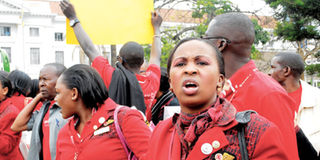Kenya Airways reports Sh4.7bn loss, the biggest by a listed firm in Kenya

Disgruntled: A demonstration in Nairobi by some of the airline’s retrenched workers recently. The airline’s chief executive, Mr Titus Naikuni, has said the Sh826 million one-off staff retrenchment also hit the airline’s first half’s performance.
What you need to know:
- The low performance is a pointer to the beating that the rest of the tourism industry is taking after Kenya declared its war against the Al-Shabaab militia group in Somalia
- A 50 per cent drop in travel to the coast, which is Kenya’s main tourist destination, is likely to impact on the overall earnings for the country
- Mr Naikuni said the Sh826 million one-off staff retrenchment costs also hit the airline’s first half’s performance but expects a Sh1.2 billion in savings going forward annually
Kenya Airways on Tuesday reported the biggest half-year loss by a listed company in Kenya, as rising costs and falling passengers numbers ate into its margins.
The national carrier, which recently retrenched over 599 workers as a cost-cutting measure, recorded a Sh4.7 billion loss for the first half of its financial year ending September 2012, down from Sh2 billion after tax profit recorded over the same period in 2011.
The management attributed the loss to declining passenger revenues, a strengthening local currency and escalating costs.
“We were unable to predict what was happening in the market place correctly, and this is one of the reasons we had to pull out of daily flights to London. We also suspended operations to Rome, Muscat and Zanzibar in order to reduce loss-making routes,” Kenya Airways chief executive Titus Naikuni said in a press conference after releasing the results on Tuesday.
But analysts at Standard Investment Bank (SIB) said that though they had expected the airline to post a low performance, the loss was above their projections.
“We were expecting a loss but the results came in a lot weaker than our estimates. The dismal performance was driven mainly by a lower uptake of placed capacity during the period,” SIB said in a research note to investors while reacting to the results.
The company share priced dropped by 3.6 per cent to close at Sh12 down, after opening at Sh12.45 per share.
Kenya Airways was also affected by security concerns in the country, with several travel advisories issued in the period. Also, the eurozone crisis slowed tourism and threw the global aviation industry into turmoil.
“The Kenyan market was negatively impacted by travel advisories which contributed to reduced passenger numbers to Kenya,” the airline said in a commentary accompanying the results.
The low performance is a pointer to the beating that the rest of the tourism industry is taking after Kenya declared its war against the Al-Shabaab militia group in Somalia, despite a concerted government effort to downplay its impact on the industry.
“The eurozone crisis and negative publicity in Europe on Kenya’s security situation has seen the number of passengers from London to Mombasa drop by 50 per cent in the period,” Mr Naikuni said.
A 50 per cent drop in travel to the coast, which is Kenya’s main tourist destination, is likely to impact on the overall earnings for the country. But it is hotel owners who will continue facing prospects of empty rooms.
Other challenges
The airline also highlighted other challenges, such as lack of double taxation agreements with other African countries.
Its turnover dropped 9.3 per cent to Sh49.8billion in the six months to September 2012, down from the Sh54.932, mainly driven by a decline in passenger revenues.
The airline said the cut in capacity on the London route significantly affected its revenues given that Europe accounts for about 30 per cent of its total income.
Mr Naikuni said the Sh826 million one-off staff retrenchment costs also hit the airline’s first half’s performance but expects a Sh1.2 billion in savings going forward annually.
The firm expects benefits of around Sh400m to be accrued this year from the retrenchment exercise. Its total costs rose to Sh55.3 billion, from Sh53.9 billion previously. Passenger revenues declined from Sh48.6billion in 2011 to Sh43.6billion.
“The causal factor for this decline is mainly weakening demands in passenger business as well as sustained pressure on yields,” the airline said. This negative performance has made the airline issue a profit warning for the full year results on grounds that it does not expect to fully offset the first half loss.
“Though the second half is expected to be much better, we believe that it will not be able to lift us past the Sh6 billion comprehensive loss we have made in the first half. So, based on capital markets guidelines, we issue a profit warning because we believe our full year results will be lower by more than 25 per cent compared with last year,” the airline’s chief finance officer Alex Mbugua said.
Going forward, the airline says it will continue with its fleet expansion plans. This will include conversion of some its passenger planes into freighters. It also expects to continue receiving its Embraer fleet to be used partly to replace some of the capacity lost.




